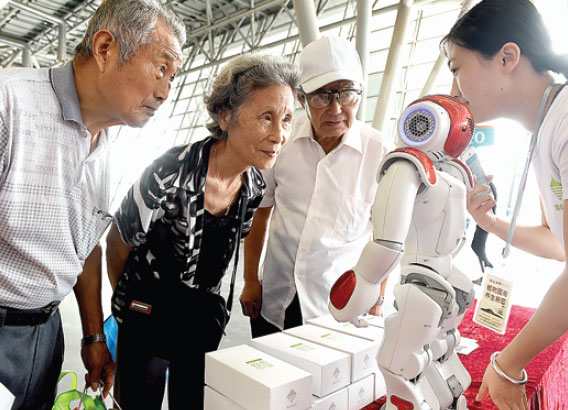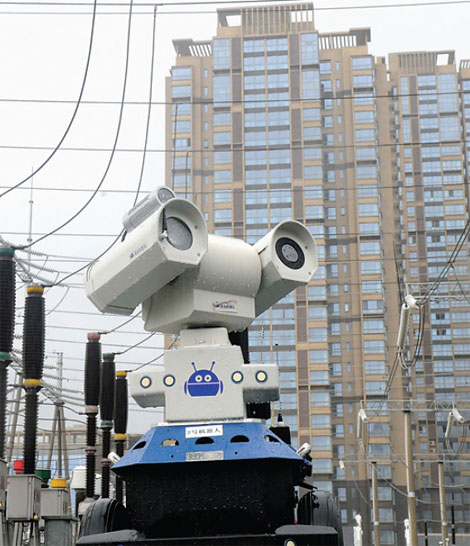Rise of the robots
Updated: 2015-09-14 07:58
By Cheng Yingqi and Shan Juan(China Daily)
|
|||||||||||
As China's population declines, experts are calling for more research into artificial intelligence, big data and smart manufacturing to maintain an economic and industrial edge and to drive development. Cheng Yingqi and Shan Juan report.
China's rapid development means it's no longer unusual to see fixed robot arms working around the clock, performing simple, highly repetitive tasks, such as welding and moving components on a typical production line.
For the factories, robots make good employees; they work long hours, don't claim wages and never complain. Meanwhile, for an aging China, with its declining birth rate, robots, particularly the industrial kind, may offer a solution to a looming labor shortage that could potentially drag down economic growth over the long term.
|
A boy is fascinated by a robotic waitress at a restaurant in Haikou, Hainan province, on Aug 3. Guo Cheng / Xinhua |
|
Visitors examine a robot designed to serve the elderly at an expo in Anhui province, on Aug 14. Guo Chen / Xinhua |
|
A robot monitors power-transmission equipment during a rainstorm in Chuzhou, Anhui, on Aug 10. Song Weixing / For China Daily |
The expected population shortfall has prompted widespread concerns that China will be over the hill before attaining its goal of becoming the world's leading economy. In response, the central government has relaxed the three-decades-old family planning policy that restricted most couples to one child.
Lu Jiehua, professor of sociology at Peking University, ruled out the possibility that the new policy will be the game changer that reverses the population decline, citing a change in public attitudes toward reproduction and family size.
By April, only 1.37 million of the 11 million couples eligible to have a second child had filed an application, according to the National Health and Family Planning Commission.
Official statistics showed that China's potential workforce, people ages 16 to 59, peaked around 2011, and has been in decline since. At the same time, the number of people working has been declining as a proportion of total population.
Last year, there were 916 million people between the ages of 16 and 59 in China, roughly 66 percent of the entire population. The proportion hit a peak of 74.5 percent in 2010, and has been falling ever since.
Lu's perception that robots offer a relatively simple solution to the problem is shared by other experts, such as Wang Weiming, deputy director of the Equipment Department at the Ministry of Industry and Information Technology.
"The development of the robotics industry will solve the labor shortage in China efficiently, thus reducing labor costs for manufacturing industry," Wang said, adding that skilled workers only account for 13 percent of national employment, resulting in a shortfall of 33 million people.
Despite the fact that manufacturers are offering ever higher salaries, the majority of young people are unwilling to engage in labor-intensive occupations.
An industrial robot, however, can do the work of an average six skilled workers on two shifts on a production line.
"Moreover, the robots are not simply replacements for manpower because they also better ensure the consistency of quality control in every batch of items, which helps manufacturers to raise productivity and optimize labor distribution," Wang said.
Job makers or breakers?
The fact that robots - which don't require air-conditioned offices, paid vacations or frequent salary raises - appear to be ideal employees and few humans can hope to compete with them, naturally raises another question: What if robots perform so well that humans become redundant and unemployment rises?
Industry experts said that such a scenario is improbable. "It's unlikely that there will be a conflict between the installation of robots and employment levels in China in the next five years," Qu Daokui, president of Siasun Robot & Automation Co, said.
Qu said the application of industry robots is limited to only a few fields such as welding, hauling and stacking - repetitive, strenuous manual labor that few people wish to do - so using robots to replace the humans currently engaged in these tasks is unlikely to affect the employment rate.
Statistics released by the International Federation of Robotics shows that the major applications for industrial robots include handling, welding, assembly, dispensing, processing and "clean room" work in dust-free environments.
Although most of the robots are used on automobile production lines (38 percent) and the manufacturing of electronic products (27.6 percent), they are also gradually being adopted by traditionally labor-intensive industries, such as foodstuffs and plastic wares, sectors that have suffered most from the labor shortage in recent years.
"From Germany to South Korea to China, a direct factor in employment has been the economic cycle of a country, not the rising number of robots being installed," Qu said.
Wang Yuechao, director of the Bureau of Major R&D Programs at the Chinese Academy of Sciences, said that based on current technology, robots are unable to perform complex tasks that are currently undertaken by senior skilled workers.
"A six-joint robot is already the most sophisticated thing that engineers can build using the current available technology, but its flexibility doesn't compare with our hands at all," Wang said. "So the range of jobs in which robots will replace humans is too narrow to threaten overall employment levels."
Moreover, a report by the International Federation of Robotics said a prosperous robotics industry could created 1 million to 2 million jobs between 2017 and 2020.
"Our study proves that robots create jobs," said Gudrun Litzenberger, general secretary of the federation, in a written statement.
Take Germany, for example, where the number of robots per 10,000 workers rose from 146 in 2000 to 261 in 2011, accelerating manufacturing volume and lowering the unemployment rate from 6.9 percent to 6 percent.
"It's a fact that productivity and competitiveness are indispensable for a manufacturing enterprise to be successful in the global market. Robotics and automation are the solution," Litzenberger said.
The way ahead?
The pursuit of economic growth and high employment has been a top priority for governments around the world in the wake of the 2008 global economic crisis. As a result, many countries have turned to automation.
In 2011, US President Barack Obama included a National Robotics Initiative as part of the wider Advanced Manufacturing Initiative to boost US efforts in automation and robotics.
In 2012, the European Commission set out a plan for a "revolution" to re-industrialize Europe and boost economic growth, with the goal of increasing the contribution of industry to the EU's total GDP to 20 percent by 2020. Robotics and automation is a significant part of the plan.
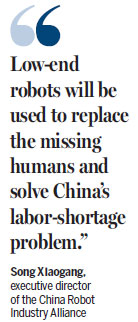
In recent years, Japan, South Korea and China have all published plans for the development of robotics.
"Some people ask why developed countries need to develop robots when they barely have any strenuous manual work for the robots to do. The answer is that these countries and regions are trying to solve a different problem to China," said Song Xiaogang, executive director of the China Robot Industry Alliance.
"Smart manufacturing" - the use of advanced technologies, such as robotics and 3-D printers, in tandem with a highly skilled workforce - is the ultimate goal of the re-industrialization trend in these highly developed economies, Song said.
"The intention of smart manufacturing is to use automated technology to greatly shorten the R&D period, and thus increase the competitiveness of the companies," Song said.
Currently, complex testing and quality-control procedures mean that launching a product can be a prolonged process. However, if a computer can precisely simulate the testing and production processes, the development period could be shortened correspondingly.
"A precondition for computers to accurately simulate a real production scenario is that the entire production line must be fully automated, or completely controlled by the computer," Song said. "Developed countries such as the US, Japan and South Korea have accumulated enough data for smart manufacturing after spending many years developing the use of robotics, while China is a beginner at this stage."
Despite being a latecomer, China is not resigned to being a follower: a robotics industry guideline published by the Ministry of Industry and Information Technology in early 2014 spelled out two major objectives for the industry: meeting the huge market demand for low-end robots, and developing high-end robots.
"Low-end robots will be used to replace the missing humans and solve China's labor-shortage problem. In the meantime, it's equally important that we develop our own high-end robots and collect more data from increasingly automated production so we will be able to develop our own smart manufacturing," Song said.
A future dilemma
Since the very beginnings of robotics research, concerns such as those related in Aesop's fable The Farmer and the Snake - about a farmer who tries to save a freezing snake by placing it in his jacket, only to be fatally bitten when the animal recovers - have never been far from people's minds.
In December, the British scientist Stephen Hawking told the BBC that the development of full artificial intelligence could "spell the end of the human race". A month later, Microsoft's Bill Gates said humans should be worried about the threat posed by artificial intelligence.
What makes Hawking and Gates so nervous is not the sight of the endlessly repetitive robotic arms on production lines, but the dream of the founders of robotic science: the creation of a machine capable of independent sensation, thought and action.
"If we feel the wind is rising, we consider putting on a coat, and then we get a coat and put it on. In the past few decades, what we have done in robotics development has focused on giving robots the ability to grab a coat and put it on - the ability to act - but we have not given them the ability to perceive and think, which is the most difficult part," Xu Yangsheng, a member of the Chinese Academy of Engineering, told the 2015 China Conference of Artificial Intelligence, held in Beijing on July 25 and 26.
"Now is the time to be open to the idea of creating intelligence for robots," he said.
Artificial intelligence research began at a 1956 conference at Dartmouth College in the US, and early pioneers were convinced that it would only take a few decades to build a machine as intelligent as a human being.
That vision later proved to be a serious underestimation of the complexity of the task, and AI development entered a slow phase.
However, fast-paced improvements in hardware and the relatively recent development of big data - large, complex sets of data that can provide insights that lead to better, more accurate decision-making - have brought hope for the future of AI. Between 2009 and 2013, about $17 billion was poured into the global AI sector, which grew at more than 60 percent a year, according to a 2014 report published by the quantitative analysis company Quid.
"The development of the Internet and big data has brought a new spring for the development of AI, because big data on the Internet provides plenty of materials for AI, and thus promotes the comprehensiveness and accuracy of its learning ability," said Tan Tieniu, deputy secretary-general of the Chinese Academy of Sciences.
"However, it's still too early to say that robots are becoming smarter than humans because there's still a long way to go before we come close to developing a general-purpose AI," he said.
Technological advances have enabled robots to outperform humans in a number of specific fields, such as face and voice recognition and piloting aircraft, but as yet no one has figured out how to incorporate these abilities into one device.
"AI represents the direction of future development. I don't believe that AI will surpass the human race, but it will influence our society, so it's high time for us to start AI research from the perspective of the social sciences," Tan said.
"An Chinese old maxim says: 'Water can float your boat, but it can also sink it', so whether AI will turn out to be a demon will depend heavily on how we handle its development."
Contact the writers at chengyingqi@chinadaily.com.cn and shanjuan@chinadaily.com.cn
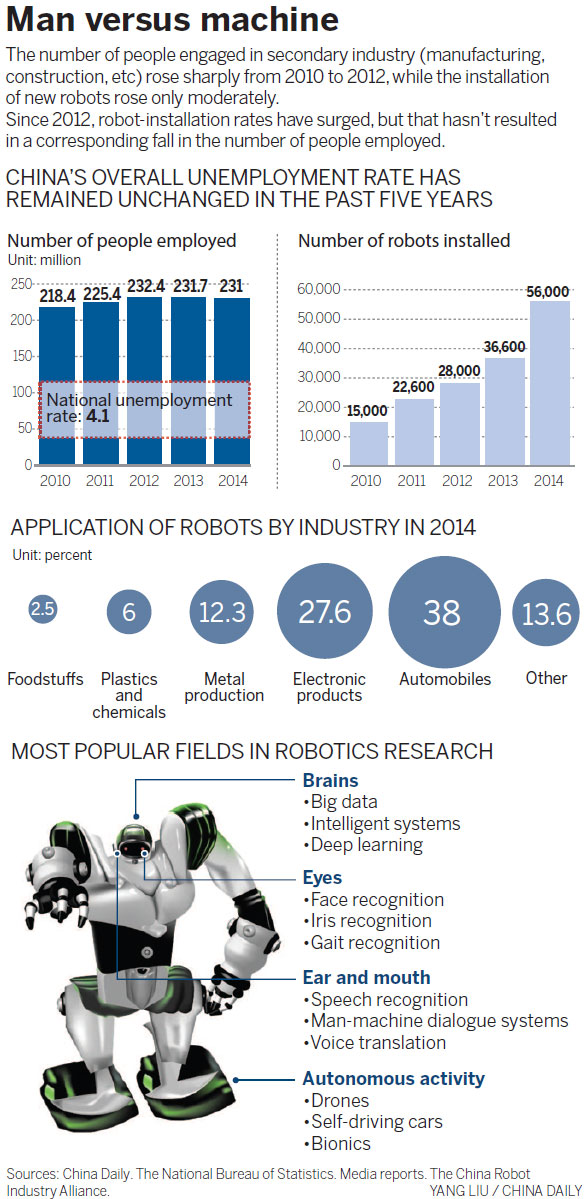
(China Daily 09/14/2015 page6)
Today's Top News
British MPs reject assisted dying bill
Chinese nuclear plant may be built in UK sooner than planned
US to accept 10,000 Syrian refugees
China, Arab States to explore cooperation
Greek conservative to seek pact with leftists first if he wins election
Russian military experts present in Syria
Britain calls for talks to calm Northern Ireland crisis
Hungarian TV journalist fired for tripping up fleeing migrants
Hot Topics
Lunar probe , China growth forecasts, Emission rules get tougher, China seen through 'colored lens', International board,
Editor's Picks

|
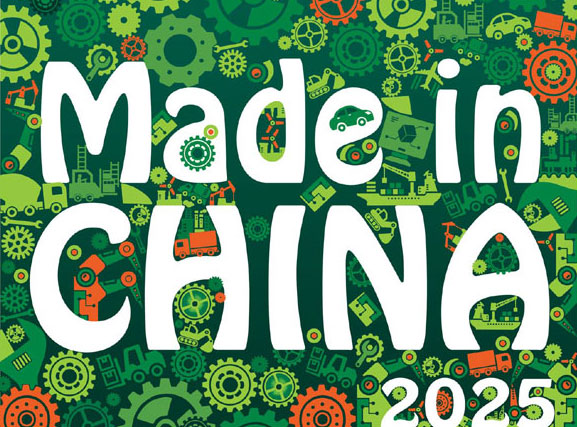
|

|

|

|

|

